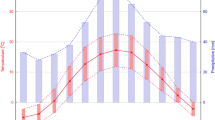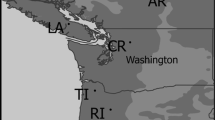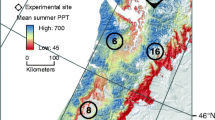Abstract
Recommendations on suitable seed sources for reforestation are usually model based and include uncertainties arising from model assumptions, parameter estimation, and future climate scenarios. Due to the long-lived nature of forests, such uncertainties need to be considered when developing guidance for managers and policy makers. We evaluate the uncertainties and apply our recently developed genetically based models, Universal Response Functions (URFs) in Austria and Germany. The URFs predict growth performance (dominant height and basal area at age 24) of Douglas-fir (Pseudotsuga menziesii [Mirbel] Franco) populations, as a function of both environmental and genetic factors. We evaluated the URFs by comparing the predicted height growth performances with observations from independent provenance trial data across Europe. Also, the sensitivity of the URF variables and the overall model uncertainty were estimated and compared to the uncertainty due to climate change projections. Model evaluation suggests that the URFs perform better in Central and Southeastern Europe compared to maritime Western Europe. Summer drought and mean annual temperature of planting sites were the most sensitive variables of the models, whereas the mean annual temperature of seed origin was the least sensitive. Model uncertainty increased with mean annual temperature of the planting site. Uncertainty due to projected future climate was found to be higher than the model uncertainty. The URFs predicted that provenance regions of southwest Germany and southeast Austria below 1500 m altitude will be suitable, whereas Pannonian east of Austria will become less suitable for growing Douglas-fir in future. Current seed stands in North America providing planting materials for Europe under the legal framework of the Organization for Economic Cooperation and Development shall continue to provide the most suitable seed material also in the future.








Similar content being viewed by others
References
Albert M, Hansen J, Nagel J et al (2015) Assessing risks and uncertainties in forest dynamics under different management scenarios and climate change. For Ecosyst 2:14
Andalo C, Beaulieu J, Bousquet J (2005) The impact of climate change on growth of local white spruce populations in Québec, Canada. For Ecol Manage 205:169–182
Audet C, Orban D (2006) Finding optimal algorithmic parameters using derivative-free optimization. SIAM J Optim 17:642–664
Aussenac G (1980) Premiers résultats d’une étude de l’influence de l’alimentation en eau sur la croissance des arbres dans un peuplement de Douglas (Pseudotsuga menziesii (Mirb.) Franco) [Preliminary results of a study on the influence of the availability of water on the growth of trees in a stand of Douglas-fir (Pseudotsuga menziesii [Mirb.] Franco)]. Revue Forestière Française 32(2):167–172
Ballian D, Mikic T, Pintaric K (2002) Provenance trials with Douglas-fir (Pseudotsuga menziesii (Mirb) Franco) at Blinje site near Kresevo. Works of the Faculty of Forestry, University of Sarajevo 1:9–18
Bansal S, Harrington CA, Gould PJ, St Clair JB (2014) Climate-related genetic variation in drought-resistance of Douglas-fir (Pseudotsuga menziesii). Glob Change Biol 21(2):947–958
Block K, Mauritsen T (2013) Forcing and feedback in the MPI-ESM-LR coupled model under abruptly quadrupled CO2. J Adv Model Earth Syst 5:676–691
Bolte A, Ammer C, Löf M et al (2009) Adaptive forest management in central Europe: climate change impacts, strategies and integrative concept. Scand J For Res 24:473–482
Burnham KP, Anderson DR (2002) Model selection and multimodel inference: a practical information-theoretic approach. Springer, New York
Carter KK (1996) Provenance tests as indicators of growth response to climate change in 10 north temperate tree species. Can J For Res 26:1089–1095
Chakraborty D, Wang T, Andre K et al (2015) Selecting populations for non-analogous climate conditions using universal response functions: the case of Douglas-fir in Central Europe. PloS One 10:e0136357
Dormann CF, Elith J, Bacher S et al (2013) Collinearity: a review of methods to deal with it and a simulation study evaluating their performance. Ecography 36:27–46
Ducci F, Tocci A (1987) Primi risultati della sperimentazione IUFRO 1969-70 su (Pseudotsuga menziesii (Mirb.) Franco) Franco nell’appennino centro-sette [First results of IUFRO/1969-70 experimentation on (Pseudotsuga menziesii (Mirb.) Franco) in Northern and Central Apennines]. Annali dell’Istituto Sperimentale per la Selvicoltura, Arezzo 18:215–289
Eckhart T, Hintsteiner W, Lair G, van Loo M, Hasenauer H (2014) The impact of soil conditons on the growth of Douglas-fir in Austria. Austrian J For Sci 131(2):107–127
Eilmann B, de Vries SMG, den Ouden J et al (2013) Origin matters! Difference in drought tolerance and productivity of coastal Douglas-fir (Pseudotsuga menziesii (Mirb.)) provenances. For Ecol Manag 302:133–143
European Union (2000) Council Directive 1999/105/EC of 22 December 1999 on the marketing of forest reproductive material. Off J Eur Commun 11:17–40
Gardner RH, Dale VH, O’Neill RV (1990) Error propagation and uncertainty in process modelling. In: Dixon RK, Meldahl RS, Ruark GA, Warren WG (eds) Process modeling of forest growth responses to environmental stress. Timber Press, Portland, pp 208–219
Hallgren WS, Pitman AJ (2000) The uncertainty in simulations by a global biome model (BIOME3) to alternative parameter values. Glob Change Biol 6:483–495
Hammonds JS, Hoffman FO, Bartell SM (1994) An introductory guide to uncertainty analysis in environmental and health risk assessment. US DOE, Washington, DC.
Hijmans RJ, Cameron SE, Parra JL et al (2005) Very high resolution interpolated climate surfaces for global land areas. Int J Climatol 25:1965–1978
Isaac-Renton MG, Roberts DR, Hamann A, Spiecker H (2014) Douglas-fir plantations in Europe: a retrospective test of assisted migration to address climate change. Glob Change Biol 20:2607–2617
Kapeller S, Lexer MJ, Geburek T et al (2012) Intraspecific variation in climate response of Norway spruce in the eastern Alpine range: selecting appropriate provenances for future climate. For Ecol Manag 271:46–57
Karasözen B (2007) Survey of trust-region derivative free optimization methods. J Ind Manag Optim 3:321–334
Kenk G, Thren M (1958) Ergebnisse verschiedener Douglasien provenienzversuche in Baden-Württemberg. Teil I. Der Internationale Douglasien-Provenienzversuch 1958 [Results of different Douglas-fir provenance trials in Baden-Württemberg. Part I: The International Douglas-fir Provenance Trial 1958]. Allgemeine Forst und Jagdzeitung 155(7/8):165–184
Kölling C (2008) Die Douglasie im Klimawandel: Gegenwärtige und zukünftige Anbaubedingungen in Bayern. LWF Wissen, Bavaria, Germany, pp 12–21
Konnert M, Ruetz W (2006) Genetic aspects of artificial regeneration of Douglas-fir (Pseudotsuga menziesii) in Bavaria. Eur J For Res 125:261–270
Konnert M, Fady B, Gömöry D, et al. (2015) Use and transfer of forest reproductive material in Europe in the context of climate change. European Forest Genetic Resources Programme (EUFORGEN), Bioversity International, Rome, Italy. xvi and p 75
Körkel S, Qu H, Rücker G, Sager S (2005) Derivative based vs. derivative free optimization methods for nonlinear optimum experimental design. In: Zhang W, Tong W, Chen Z, Glowinski R (eds) Current trends in high performance computing and its application: proceedings of the international conference on high Performance computing and applications, August 8-10, 2004, Shanghai, P.R. China. Springer, Berlin, pp 339–344
Kranenborg KG, de Vries SM (1995) Douglas fir provenance research in the Netherlands: 1966 67 IUFRO Series. IBN Research Report, 95/1, p 27. Institute for Forestry and Nature Research, Wageningen.
Lally M, Thomson D (1998) Best seed origins for Douglas-fir. Coillte Research and Development, Information note No 17, Newtownmountkennedy, Co. Wicklow
Lexer MJ, Hönninger K (2004) Effects of error in model input: experiments with a forest patch model. Ecol Model 173:159–176
Lindner M, Fitzgerald JB, Zimmermann NE et al (2014) Climate change and European forests: what do we know, what are the uncertainties, and what are the implications for forest management? J Environ Manag 146:69–83
Loehle C (1997) A hypothesis testing framework for evaluating ecosystem model performance. Ecol Model 97:153–165
Loehle C, LeBlanc D (1996) Model-based assessments of climate change effects on forests: a critical review. Ecol Model 90:1–31
Lumley T (2009) Leaps: regression subset selection. R package. The Comprehensive R Archive Network, Washington
Magnesen S (1986) The International Short Term Douglas-fir (Pseudotsuga menziesii (Mirb.) Franco) Provenance Experiment in West Norway, Meddelelser Fra Norsk Institutt for Skogforskning, pp 295–312
Marris E (2008) Moving on assisted migration. Nat Rep Clim Change 2:112–113
Matyas C (1994) Modeling climate change effects with provenance test data. Tree Physiol 14:797–804
McLachlan JS, Hellmann JJ, Schwartz MW (2007) A framework for debate of assisted migration in an era of climate change. Conserv Biol 21:297–302
Millar CI, Stephenson NL, Stephens SL (2007) Climate change and forests of the future: managing in the face of uncertainty. Ecol Appl 17:2145–2151
Montwé D, Spiecker H, Hamann A (2015) Five decades of growth in a genetic field trial of Douglas-fir reveal trade-offs between productivity and drought tolerance. Tree Genet Genomes 11:1–11
Nanson A (1978) Belgian Provenance Experiments with Douglas-fir, Grand fir and Sitka spruce. In: Proceedings of the IUFRO joint meeting of working parties, Vancouver, Canada, 1978, vol 2, 335–346. B.C. Ministry of Forests Information Services Branch, Victoria
OECD (2012) Forest seed and plant scheme 2012 rules and regulations OECD scheme for the certification of forest reproductive. OECD, Paris
Pearson RG, Thuiller W, Araújo MB et al (2006) Model-based uncertainty in species range prediction. J Biogeogr 33(10):1704–1711
Perić S, Jazbec A, Mladen I (2005) Analysis of height and diameter breast height for Douglas-fir provenances test. In: Luzar V, Dobric VH (eds) 27th International Conference Information Technology Interfaces ITI 2005, June 20–23, Cavtat, p 4. SRCE University Computing Centre, University of Zegreb, Cavtat
Perić S, Jazbec A, Tijardovi M, Margaleti J, Mladen I, Pila I, Medak J (2009) Provenance studies of Douglas-fir in the locality of Kontija (Istria). Periodicum Biologorum UDC 57:61 111(4):487–493
Petkova K (2011) Investigation of Douglas-fir provenance test in North-Western Bulgaria at age 20. For Ideas 17(2):42
R Core Team (2013) R Core Team. R: a language and environment for statistical computing R Foundation for statistical computing, Vienna, Austria ISBN 3–900051–07–0. http://www.R-project.org/
Reyer C (2013) The cascade of uncertainty in modeling forest ecosystem responses to environmental change and the challenge of sustainable resource management. Doctoral Thesis. Mathematisch-Naturwissenschaftliche Fakultät II Humbodt Unviversität Berlin 168
Rios LM, Sahinidis NV (2013) Derivative-free optimization: a review of algorithms and comparison of software implementations. J Global Optim 56:1247–1293
Schlueter M, Munetomo M (2013) User guide. Technical report, Hokkaido University, Japan (HUSCAP) (2013). http://www.midacosolver.com/data/other/MIDACO_User_Guide.pdf
Schober R (1955) Douglasien Provenienzversuche [Douglas-fir Provenance Trials]. Allgemeine Forst- und Jagdzeitung 125(5):160–179
Sika A, Pav B (1990) Vyskovy Rust Douglasky Na Proveniencnich Plochach CR V Ruznych Fazich Vyvoje [Height Growth of Douglas Firs in Different Developmental Phases on Provenance Areas in the Czech Republic]. Lesnictvi 36:367–380
Silander V, Lehtonen J, Nikkanen T (2000) Pseudotsuga Douglaskuusi. In: Silander V, Lehtonen J, Nikkanen T (eds) Ulkomaisten havupuulajien menestyminen Etela-Suomessa [Performance of exotic conifers in Southern Finland], pp 81–84. Mets¨antutkimuslaitoksen tiedonantoja, Vantaa, Mets¨antutkimuslaitos, Muhoksen Tutkimusasema.
Spadavecchia L, Williams M, Law BE (2011) Uncertainty in predictions of forest carbon dynamics: separating driver error from model error. Ecol Appl: A Publ Ecol Soc Am 21:1506–1522
Spittlehouse DL, Stewart RB (2003) Adaptation to climate change in forest management. BC J Ecosyst Manag 4:1–11
St Clair JB, Mandel NL, Vance-Borland KW (2005) Genecol Douglas-fir in Western Oregon and Washington. Ann Bot 96:1199–1214
Temperli C, Bugmann H, Elkin C (2012) Adaptive management for competing forest goods and services under climate change. Ecol Appl 22:2065–2077
van Vuuren DP, Edmonds J, Kainuma M et al (2011) The representative concentration pathways: an overview. Clim Change 109:5–31
Wang T, Hamann A, Yanchuk A et al (2006) Use of response functions in selecting lodgepole pine populations for future climates. Glob Change Biol 12:2404–2416
Wang T, O’Neill GA, Aitken SN (2010) Integrating environmental and genetic effects to predict responses of tree populations to climate. Ecol Appl 20:153–163
Wang T, Campbell EM, O’Neill GA, Aitken SN (2012a) Projecting future distributions of ecosystem climate niches: uncertainties and management applications. For Ecol Manag 279:128–140
Wang T, Hamann A, Spittlehouse DL, Murdock TQ (2012b) ClimateWNA—high-resolution spatial climate data for Western North America. J Appl Meteorol Climatol 51:16–29
Yang J, Pedlar JH, McKenney DW, Weersink A (2015) The development of universal response functions to facilitate climate-smart regeneration of black spruce and white pine in Ontario, Canada. For Ecol Manag 339:34–43
Acknowledgments
We would like to thank Marlene Eder (BFW, Vienna), Wolfrad Rütz, Gerhard Huber, and Manuela Heintz (ASP, Teisendorf, Germany) for helping in data compilation. We would also like to acknowledge the support of all present and former colleagues of BFW and ASP who undertook field measurement at the Douglas-fir trials. The study was funded by the Austrian climate research programme ACRP 4th Call for Proposals, Project No. B175092.
Author information
Authors and Affiliations
Corresponding author
Additional information
Communicated by Arne Nothdurft.
Electronic supplementary material
Below is the link to the electronic supplementary material.
Rights and permissions
About this article
Cite this article
Chakraborty, D., Wang, T., Andre, K. et al. Adapting Douglas-fir forestry in Central Europe: evaluation, application, and uncertainty analysis of a genetically based model. Eur J Forest Res 135, 919–936 (2016). https://doi.org/10.1007/s10342-016-0984-5
Received:
Revised:
Accepted:
Published:
Issue Date:
DOI: https://doi.org/10.1007/s10342-016-0984-5




